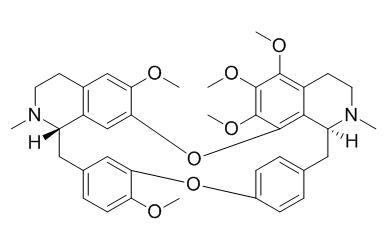Thalrugosaminine
Thalrugosaminine shows promising antibacterial activity with MIC values of 64-128ug/ml and Staphylococcus species is the most sensitive strains. Thalrugosaminine possesses hypotensive activity in rabbits and is active against Mycobacterium smegmatis.
Inquire / Order:
manager@chemfaces.com
Technical Inquiries:
service@chemfaces.com
Tel:
+86-27-84237783
Fax:
+86-27-84254680
Address:
1 Building, No. 83, CheCheng Rd., Wuhan Economic and Technological Development Zone, Wuhan, Hubei 430056, PRC
Providing storage is as stated on the product vial and the vial is kept tightly sealed, the product can be stored for up to
24 months(2-8C).
Wherever possible, you should prepare and use solutions on the same day. However, if you need to make up stock solutions in advance, we recommend that you store the solution as aliquots in tightly sealed vials at -20C. Generally, these will be useable for up to two weeks. Before use, and prior to opening the vial we recommend that you allow your product to equilibrate to room temperature for at least 1 hour.
Need more advice on solubility, usage and handling? Please email to: service@chemfaces.com
The packaging of the product may have turned upside down during transportation, resulting in the natural compounds adhering to the neck or cap of the vial. take the vial out of its packaging and gently shake to let the compounds fall to the bottom of the vial. for liquid products, centrifuge at 200-500 RPM to gather the liquid at the bottom of the vial. try to avoid loss or contamination during handling.
Nat Prod Commun.2017, 12(5):771-778
Int J Mol Sci.2022, 23(5):2796.
Univerzita Karlova2022, 228192.
Phytomedicine.2019, 61:152813
Phytomedicine.2023, 114:154813.
Int J Mol Sci.2021, 22(2):770.
Plant Direct.2021, 5(4):e00318.
J Agric Food Chem.2019, 67(27):7748-7754
Korean J. Medicinal Crop Sci.2023, 31(5):283-289.
Journal of Applied Pharmaceutical Science2022, 0(00), pp:001-007
Related and Featured Products
J Ethnopharmacol. 2016 Dec 4;193:221-226.
Isolation and characterization of three benzylisoquinoline alkaloids from Thalictrum minus L. and their antibacterial activity against bovine mastitis.[Pubmed:
27426505]
The roots of Thalictrum minus are traditionally used in the treatment of inflammation and infectious diseases such as bovine mastitis. However, there are no reports available in literature till date regarding the antibacterial studies of T. minus against bovine mastitis.
The present study was undertaken to evaluate the antibacterial potential of crude extract of T. minus (root) and some of its isolated constituents against bovine mastitis in order to scientifically validate its traditional use.
METHODS AND RESULTS:
A total of three alkaloid compounds were isolated from the DCM: MeOH extract of roots of T. minus using silica gel column chromatography. Structural elucidation of the isolated compounds was done by using spectroscopic techniques like mass spectrometry and NMR spectroscopy. Pathogens were isolated from cases of bovine mastitis and identified by using 16S rRNA gene sequencing. The broth micro-dilution method was used to evaluate the antibacterial activities of DCM: MeOH extract and isolated compounds against mastitis pathogens.
The three isolated compounds were identified as benzylisoquinoline alkaloids (1) 5'-Hydroxythalidasine, (2) Thalrugosaminine and (3) O-Methylthalicberine. Compounds (2) and (3) are reported for the first time from the roots of T. minus. Five mastitis pathogens viz., Staphylococcus xylosus, Staphylococcus lentus, Staphylococcus equorum, Enterococcus faecalis and Pantoea agglomerans were identified on the basis of sequence analysis of isolates using the nucleotide BLAST algorithm. This study reports for the first time the isolation and molecular characterization of mastitis pathogens from Kashmir valley, India. The DCM: MeOH extract exhibited broad spectrum antibacterial activities that varied between the bacterial species (MIC=250-500µg/ml). 5'-Hydroxythalidasine and Thalrugosaminine showed promising antibacterial activity with MIC values of 64-128µg/ml while Staphylococcus species were found to be the most sensitive strains.
CONCLUSIONS:
The antibacterial activities of the DCM: MeOH extract and isolated compounds support the traditional use of T. minus in the treatment of bovine mastitis.
Lloydia. 1977 Sep-Oct;40(5):508-14.
Alkaloids of Thalictrum. XXII. Isolation of alkaloids with hypotensive and antimicrobial activity from Thalictrum revolutum.[Pubmed:
144834]
METHODS AND RESULTS:
Sixteen alkaloids were characterized from Thalictrum revolutum DC., namely; thalidasine, O-methylthalmethine, O-methylthalicberine, Thalrugosaminine, thalicarpine, thalmelatine, pennsylvanine, palmatine, berberine, thalifendine, columbamine, jatrorrhizine, deoxythalidastine, thalphenine and magnoflorine. The structure of thairugosaminine (1) a bisbenzylisoquinoline type which was previously proposed on partial data was completely established, including the absolute configuration as S,S.
CONCLUSIONS:
Thalphenine, thalidasine, O-methylthalicberine, thalicarpine, Thalrugosaminine and thaliglucinone were found to possess hypotensive activity in rabbits. Thalrugosaminine, thalicarpine, thalmelatine, O-methylthalmethine, pennsylvanine and thalphenine were found to be active against Mycobacterium smegmatis.



